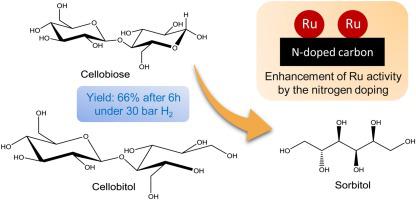Applied Catalysis B: Environment and Energy ( IF 20.2 ) Pub Date : 2020-09-06 , DOI: 10.1016/j.apcatb.2020.119515 Samuel Carlier , Jim Gripekoven , Martin Philippo , Sophie Hermans

|
With the aim to produce the platform molecule sorbitol from biomass, the two-steps transformation of the cellobiose disaccharide by hydrogenation/hydrolysis was attempted using a single catalytic material. The two reactions were first studied separately before integration. Ru nanoparticles deposited on carbon supports were tested for the hydrogenation of glucose into sorbitol. The optimal nanoparticles size was established. Two different types of carbon materials (activated coal and graphene nanoplatelets) were modified to incorporate nitrogen atoms within the carbon lattice. These N-doped carbon materials displayed higher basicity but showed no activity for the hydrolysis of cellobiose into glucose. They were used to support Ru nanoparticles and these bifunctional catalysts were studied for the hydrogenolysis of cellobiose into sorbitol. Kinetic studies showed that the doping of the carbon supports increased the activity of the Ru nanoparticles for this reaction, going through a hydrogenation followed by disaccharide splitting pathway rather than vice versa. Catalysts were reused and no sign of deactivation have been observed.
中文翻译:

N掺杂碳载体上的Ru用于将纤维二糖直接氢化成山梨糖醇
为了从生物质生产平台分子山梨糖醇,尝试使用单一催化材料通过氢化/水解对纤维二糖二糖进行两步转化。在整合之前,首先分别研究了这两个反应。测试沉积在碳载体上的Ru纳米颗粒将葡萄糖氢化成山梨糖醇。确定了最佳的纳米颗粒尺寸。修改了两种不同类型的碳材料(活性煤和石墨烯纳米片),将氮原子掺入碳晶格中。这些氮掺杂的碳材料显示出较高的碱性,但没有表现出纤维二糖水解为葡萄糖的活性。它们用于支撑Ru纳米颗粒,并研究了这些双功能催化剂将纤维二糖氢解为山梨糖醇。动力学研究表明,碳载体的掺杂提高了Ru纳米粒子在该反应中的活性,首先经历了氢化反应,然后经历了二糖分裂途径,反之亦然。催化剂已重新使用,未见失活迹象。











































 京公网安备 11010802027423号
京公网安备 11010802027423号